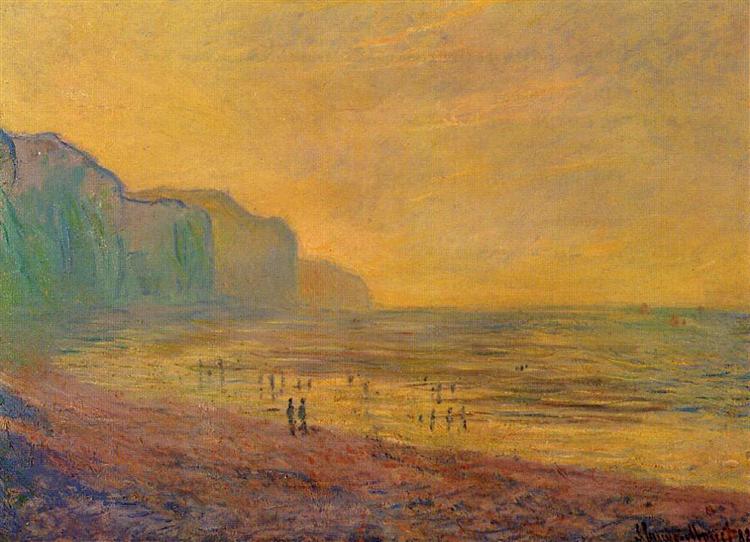Description
Claude Monet's "Low Tide at Pourville - Misty Weather" (1882) is a fascinating example of the innovative drive of his art, as well as the deep connection he had with nature and his surroundings. This painting, framed within the Impressionist movement, reveals not only Monet's technical mastery, but also his ability to capture the ephemeral essence of light and atmosphere.
In the painting, the scene presents us with a view of the coast of Pourville, a charming village in the Normandy region, which Monet visited frequently. The composition is marked by a careful arrangement that, although it seems spontaneous, reflects a meticulous study of perspective and the arrangement of elements in the landscape. The horizon unfolds through a clear line that separates the sea from a leaden sky, dominated by grey clouds that announce the hazy climate characteristic of the place.
The use of color in this work is particularly noteworthy. Monet employs a soft, subtle palette, with shades of blue, gray, and beige predominating, evoking a sense of calm and melancholy. The relationship between colors is almost abstract, with light filtering through the mist and playing with the textures of the sand, water, and sky. The technique of loose, rapid brushstrokes that Monet perfected is visible in every part of the painting, creating a vibrant play of light that seems to be in constant motion.
Although the work lacks prominent figures, tiny silhouettes of bathers and boats can be seen in the water, lending a sense of scale and humanity to the natural setting. These almost ethereal presences seem to blend into the scene, reflecting the human connection to nature, a recurring theme in Monet’s art. In the distance, the coastline and rock formations are rendered with a softness that emphasizes the tranquility of the moment captured.
It is interesting to note that "Low Tide at Pourville - Foggy Weather" is part of a series of works that Monet produced in the same locality throughout his career, each exploring different aspects of light and weather. The consistency with which he returned to this location indicates not only his personal appreciation for the landscape, but also his commitment to investigating visual perception and the fleeting nature of the moment.
Historically, the work reflects a key period in the evolution of Impressionism, when artists began to move away from the more rigid and formal compositions of academicism to focus on the representation of direct experience. Monet, in particular, was interested in capturing the atmosphere of a place, and "Low Tide at Pourville - Foggy Weather" encapsulates this quest with great precision.
The work not only invites contemplation, but also provides a glimpse into the way Monet saw the world: as an ever-changing place, full of nuance and subtlety. It is a reminder that beauty can be found in the smallest details and in the simple observation of our surroundings, a lesson that the viewer can carry with them long after they have left the work. Thus, “Low Tide at Pourville – Foggy Weather” stands not only as a masterful example of Monet’s talent, but as a milestone in art history, one that continues to resonate to this day.
KUADROS ©, a famous painting on your wall.
Hand-made oil painting reproductions, with the quality of professional artists and the distinctive seal of KUADROS ©.
Painting reproduction service with satisfaction guarantee. If you are not completely satisfied with the replica of your painting, we will refund 100% of your money.

